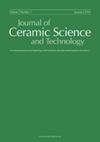Circuit-Board-Integrated Transformers Design and Manufacture
IF 0.4
4区 材料科学
Q4 MATERIALS SCIENCE, CERAMICS
引用次数: 0
Abstract
Transformers couple two sections of a circuit by electromagnetic induction. They are widely used to either transform alternating voltage levels or to transmit power or signals across galvanic isolation. Both of these functions are essential for the operation of sensors and controllers. Covering all aspects from idea to circuit performance and from design to manufacture, this paper presents the first comprehensive description of the making of miniaturized, rugged, up-to-100W transformers for embedding into multilayer circuit boards. For circular coils, the well-manageable Ampere-Laplace law is shown to yield reliable designs, predicting correctly the performance of manufactured hardware. This enables fast design without lengthy finite element modelling. In the low-power linear regime, basic relations describe how the device’s characteristics evolve from the material properties and device structure. While scattering Parameters are useful for the analysis of isolated transformers with their intrinsic parasitics, the interaction with the components of the final circuit and the aspects of power and efficiency are addressed by chain matrixes. While these design rules are similar for multilayer boards of different material (like epoxy, Teflon, ceramics), the manufacturing of ceramic board transformers is considered here in detail. Low-temperature-cofired ceramic (LTCC) boards being sintered at 900 °C are particularly suited for harsh environments with chemical or thermal stress as frequently found at sensor positions. The transformer performance usually benefits from or even requires an integrated ceramic core of higher permeability, a ferrite, to shape the magnetic flux. Methods to sinter ferrites inside a dielectric ceramic multilayerandto measure their performance are therefore described in detail.Asthe sintering behaviour of dielectricandmagnetic ceramics differs considerably, their simultaneous sintering is challenging.However, the sintering temperatures of the usefulMnZnand NiZnCu ferrites can be lowered to that of the dielectric material with only moderate loss of permeability by glass additives. Furthermore, thermal mismatch between materials causes catastrophic failure or at least stress and loss of magnetic performance during cooling to room temperature after sintering. This is avoidable by either adjusting the thermal expansion coefficient of the ferrite or by enclosing the ferrite between stressreleasing separation layers.We present the state of the art in materials development according to the first approach as well as fully functional devices made with the second technique. Other applications not directly addressed but well related to this work are characterized by low load resistance in relation to the coil resistance of the transformer. Efficient power transmission then requires that technological solutions are applied to achieve the lowest possible resistive loss inside the coils by an enlarged conductor cross-section. As this is particularly challenging for LTCC boards, a technique is discussed to fabricate conductor traces with a thickness larger than their width.电路板集成变压器的设计与制造
变压器通过电磁感应把电路的两部分连接起来。它们被广泛用于转换交流电压水平或传输电流隔离的功率或信号。这两种功能对于传感器和控制器的操作都是必不可少的。从理念到电路性能,从设计到制造,本文首次全面介绍了用于嵌入多层电路板的小型化,坚固耐用,高达100w的变压器的制作。对于圆形线圈,易于管理的安培-拉普拉斯定律显示出可靠的设计,正确预测制造硬件的性能。这使得快速设计无需冗长的有限元建模。在低功率线性状态下,基本关系描述了器件的特性如何从材料性质和器件结构演变而来。虽然散射参数对孤立变压器的本征寄生分析是有用的,但与最终电路中元件的相互作用以及功率和效率方面的问题是由链矩阵来解决的。虽然这些设计规则类似于不同材料的多层板(如环氧树脂、特氟龙、陶瓷),但这里详细考虑了陶瓷板变压器的制造。在900°C下烧结的低温共烧陶瓷(LTCC)板特别适合在传感器位置经常发现的具有化学或热应力的恶劣环境。变压器的性能通常受益于甚至需要一个高磁导率的集成陶瓷铁氧体铁芯来塑造磁通。因此,详细描述了在介电陶瓷多层内烧结铁氧体和测量其性能的方法。由于介电陶瓷和磁陶瓷的烧结行为有很大的不同,它们的同时烧结是具有挑战性的。然而,使用玻璃添加剂可以将有用的mnznand NiZnCu铁氧体的烧结温度降低到介电材料的烧结温度,并且只有适度的磁导率损失。此外,材料之间的热失配在烧结后冷却到室温时导致灾难性的失效或至少应力和磁性损失。这可以通过调整铁素体的热膨胀系数或将铁素体包裹在释放应力的分离层之间来避免。我们介绍了根据第一种方法在材料开发方面的最新进展,以及用第二种技术制造的功能齐全的设备。其他应用没有直接解决,但与这项工作密切相关的特点是低负载电阻相对于变压器的线圈电阻。因此,有效的电力传输需要采用技术解决方案,通过扩大导体横截面来实现线圈内尽可能低的电阻损耗。由于这对于LTCC板来说特别具有挑战性,因此讨论了一种制造厚度大于其宽度的导体走线的技术。
本文章由计算机程序翻译,如有差异,请以英文原文为准。
求助全文
约1分钟内获得全文
求助全文
来源期刊

Journal of Ceramic Science and Technology
MATERIALS SCIENCE, CERAMICS-
CiteScore
0.80
自引率
0.00%
发文量
0
期刊介绍:
The Journal of Ceramic Science and Technology publishes original scientific articles on all topics of ceramic science and technology from all ceramic branches. The focus is on the scientific exploration of the relationships between processing, microstructure and properties of sintered ceramic materials as well as on new processing routes for innovative ceramic materials. The papers may have either theoretical or experimental background. A high quality of publications will be guaranteed by a thorough double blind peer review process.
 求助内容:
求助内容: 应助结果提醒方式:
应助结果提醒方式:


